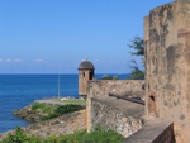History of the D. R.
A Colorful Saga

The history of the DR is a colorful saga, filled with tragedy, violence and "firsts". It's the background of its' unique and diverse culture today.
Christopher Columbus landed here at Puerto Plata in 1492, when he thought he'd found America. His original fort is still standing on the cliffs overlooking the sea.
He introduced coconut palms to the D.R., supposedly to replenish the fresh water supply for his ships, enroute to points west.
For years, the DR was a central accumulation and disbursement point for the slave trade. This has an enormous impact on the culture of the Dominicans to this day.
Some of their dance steps originate from when they had limited foot movements, restricted by the slave shackles.
The slaves were not allowed to speak, so developed a silent communication code, consisting of facial movements. Many are still used to this day. You can see them if you watch the locals' faces.
What may appear to an observer as facial ticks, actually originated as communication signals used by the slaves who were not allowed to speak.
The story of Hispaniola unfolds from 1492 - to 2004 at this page which talks about this region's fascinating
history
Cabarete's background history
Cabarete's name first appears in official documents in 1835.
This is when Zephaniah Kingsley, a slave trader and colonist plantation owner in Florida, bought the grounds located between Sosua and Sabaneta de Yassica.
He had acquired and married a 13-yr old African slave named Anna Madgigine Jai in Havanna Cuba in 1811, and brought her to Florida. He bestowed freedom on Anna and gifted her and their children with land holdings there.
Their way of life was unaffected until about 1835 when it became evident that their marriage would not be recognized, and that holdings in the name of Anna and the children might be confiscated.
Zephaniah and Anna Kingsley, under persecutions of the white colonists who refused to recognize their marriage, decided to emigrate to Santo Domingo, then under Haitian occupation.Called the “Isle of Liberty,” Haiti was the first independentblack republic in the New World, run by African descendants.
Quickly, the Kingsleys became friendly with Haitian President Boyer, and purchased the area on the north shore now called Cabarete. They settled there in 1836 with more than 50 of the Kingsley slaves who came with them as indentured servants (slavery was against the law in Haiti.)The slaves were promised freedom and land in exchangefor nine years of service.
They established a plantation there on the north shore of the Dominican Republic, then named Mayorasgo de Koka.
For 20 years this area thrived as the port of Cabarete - it's traffic growing in spite of many dangers. When Kingsley set out to return to Florida, he left his family and slaves in Cabarete.
These hearty folks are the ancestors of our current day Cabarete local inhabitants.
Return to:
Our Dominican Republic homepage
Dominican Republic - Our Island Nation
Enjoy this page? Please pay it forward. Here's how...
Would you prefer to share this page with others by linking to it?
- Click on the HTML link code below.
- Copy and paste it, adding a note of your own, into your blog, a Web page, forums, a blog comment,
your Facebook account, or anywhere that someone would find this page valuable.